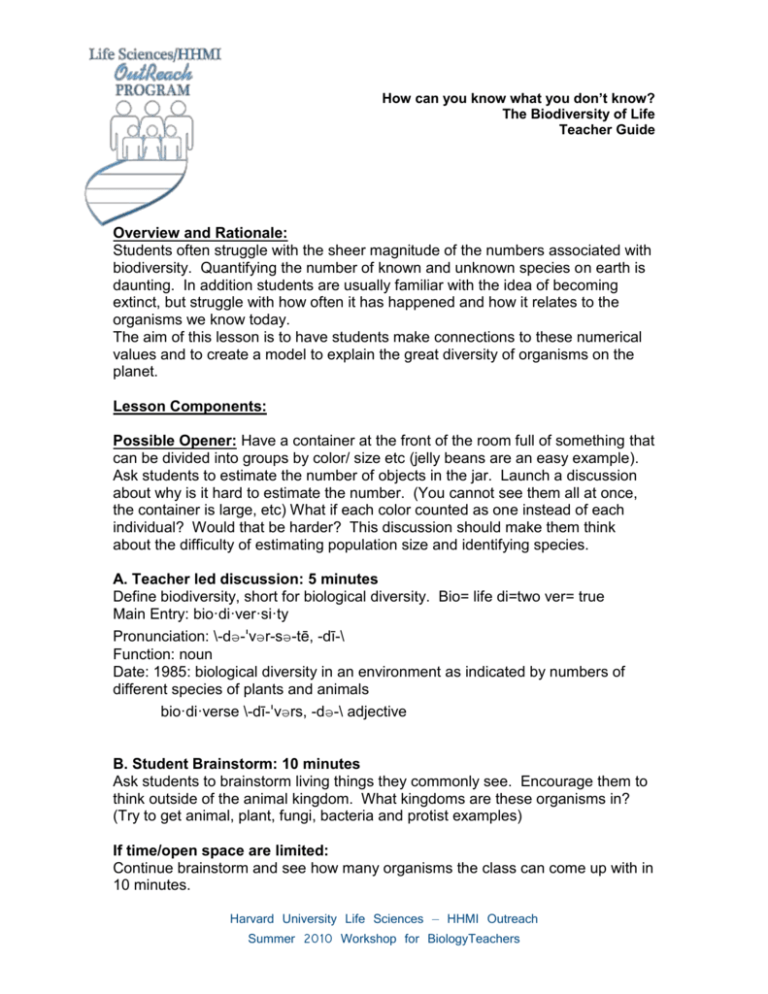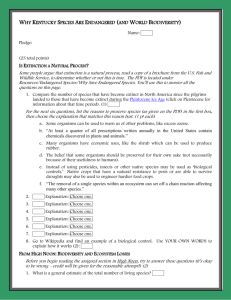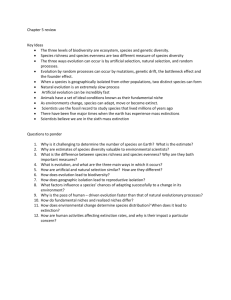Teacher Guide - Life Sciences Outreach Program
advertisement

How can you know what you don’t know? The Biodiversity of Life Teacher Guide Overview and Rationale: Students often struggle with the sheer magnitude of the numbers associated with biodiversity. Quantifying the number of known and unknown species on earth is daunting. In addition students are usually familiar with the idea of becoming extinct, but struggle with how often it has happened and how it relates to the organisms we know today. The aim of this lesson is to have students make connections to these numerical values and to create a model to explain the great diversity of organisms on the planet. Lesson Components: Possible Opener: Have a container at the front of the room full of something that can be divided into groups by color/ size etc (jelly beans are an easy example). Ask students to estimate the number of objects in the jar. Launch a discussion about why is it hard to estimate the number. (You cannot see them all at once, the container is large, etc) What if each color counted as one instead of each individual? Would that be harder? This discussion should make them think about the difficulty of estimating population size and identifying species. A. Teacher led discussion: 5 minutes Define biodiversity, short for biological diversity. Bio= life di=two ver= true Main Entry: bio·di·ver·si·ty Pronunciation: \-də-ˈvər-sə-tē, -dī-\ Function: noun Date: 1985: biological diversity in an environment as indicated by numbers of different species of plants and animals bio·di·verse \-dī-ˈvərs, -də-\ adjective B. Student Brainstorm: 10 minutes Ask students to brainstorm living things they commonly see. Encourage them to think outside of the animal kingdom. What kingdoms are these organisms in? (Try to get animal, plant, fungi, bacteria and protist examples) If time/open space are limited: Continue brainstorm and see how many organisms the class can come up with in 10 minutes. Harvard University Life Sciences – HHMI Outreach Summer 2010 Workshop for BiologyTeachers -OrB. Collection activity: 60 minute class period (If you have more time/ access to open space) The Biodiversity of Life: Exploring the Outdoors Provide students with hand lens, binoculars, field guides, various nets (skim, sweep, butterfly, fishing), plastic bags and buckets for collection. Spend a day outside the classroom identifying plants/ animals/ fungi /microorganisms from the area around the school. (worksheet in the student assignment document) Student groups can be arranged so that each individual in the group of 4 students focuses on plant or animal or fungi or microorganism and together the group collaborates. Extension activity: Students can take pictures or collect samples of plants and create a field guide for the area. Resource: Making an intertidal field guide activity (keywords: Hawaii. intertidal field guide, lesson plan ) http://www.hawaii.edu/gk-12/opihi/assessment/fgfp.pdf C. Article/book reading and discussion: 30 minutes This can be an in class or homework assignment Article “Greatest Mysteries: How Many Species Exist on Earth?” http://www.livescience.com/strangenews/070803_gm_numberspecies.html Or Chapter 1 of The Future of Life by E.O. Wilson Pg 10-21 Examples of biodiversity levels in various groups) (ISBN: 978-0679768111) Or Time Magazine Article “Vanishing Before Our Eyes” Wilson, Edward O. "Vanishing Before Our Eyes." TIME.com. Time Magazine, 26 Apr. 2000. Web. 19 July 2010. <http://www.time.com/time/printout/0,8816,996747,00.html#>. Students will read the article/chapter and summarize the main points. (Worksheet provided in the student assignment document) Students should focus on numerical estimates of species diversity and problems facing scientists trying to answer the question “how many species are there?” From Greatest Mysteries Article: “The number of identified species is around 2 million. Scientists estimate that there could be between 5-100 million species on the planet.” Summer 2010 Workshop in Biology and Multimedia for High School Teachers Harvard University Life Sciences – HHMI Outreach Program Classroom discussion question: How does this compare to the list the class created? What are some of the issues that make it difficult for scientists to determine the number of species on the planet? Relate this discussion to the opener where students estimated the number of jellybeans in a jar. (Additional ideas include: hiding something within the jar as an unanticipated “discovery”, having another jar in the cabinet that represents a very diverse yet unknown environment- you can explore this model as much or as little as you’d like) D. Student Activity: 30 minutes The Biodiversity of Life: Exploring the Numbers Students will work in groups of 2-3 to compare the number of species we identified to the number of identified species on earth. Students can focus on one kingdom or overall diversity of living things. Students will probably need access to the internet or some frame of reference. For example there are 6 billion people on earth, 1 billion seconds takes 30 years, or there are 6.5 million people in Massachusetts. Depending on students’ math ability the teacher can either provide the values below (in bold) or expect the students to accurately calculate the values independently. Calculators are necessary. Students should start with comparing: # of species listed by class: # of species identified by scientists ___:1.8 million Then compare… # of species identified by scientists: # of species estimated to live on earth 1.8 million: 5-100 million Students will take these calculations and create an analogy or comparison. I have used population of the student body as an example below, but there are endless possibilities. It’s all up to student creativity. If students are struggling for ideas the following is a list of possibilities: grains of sand, stars in the sky, cells in the body, measurements (each inch is a species, the distance from here to the moon is all the species that have ever existed) grains of rice, number of people, etc. Population example: If the class counted 100 species and there are 2 million species identified on earth… then there are 20,000 times more organisms than the class was able to list. Here is a possible analogy: If the school population of 1,200 represents the species we identified then the entire population of TEXAS (24 million) would be like all the species that have been identified on earth. Continuing that analogy if we only know 1/5 of the species that exist then scientists have identified all the people in Texas, but don’t know any of the people in California, Florida, New Summer 2010 Workshop in Biology and Multimedia for High School Teachers Harvard University Life Sciences – HHMI Outreach Program York, Maine, New Hampshire, Vermont, Massachusetts, Rhode Island, New Jersey or Connecticut! (http://www.census.gov/) Once all students have completed their math calculations and thought of an analogy the students will share their idea with the class. Teachers can modify the activity so that it is a physical model. For example fill a test tube with grains of rice to represent the known species and then fill 20 more test tubes to show how many species might exist. E. Video Clip: 30 minutes: Watch the PBS video from the Evolution series Episode 3: Extinction! Youtube link: http://www.youtube.com/watch?v=GIRMvaeVEaA (keywords: PBS, Evolution, Extinction) Ask students to take notes and focus on: -The number of species that have gone extinct. -Reasons for the Permian extinction. -Why is the mass extinction like a “house of cards”? F: Homework: Continue the analogy from the previous class. If 99.9% of all species are currently extinct, then students can take the analogy started in class and continue it. Only 1/1,000 of all species ever to live are on earth today. That is like knowing the number of people that live in Texas when 4 times the earth’s population (24 billion people) represents all the organisms that have ever existed. Wrap up: Discuss the importance of identifying the species on earth. Is maintaining the biodiversity of organisms important? What happens if one species goes extinct? How is extinction like a house of cards? Do you believe we are in the midst of another great extinction event? What areas have greater biodiversity? Why is preserving endangered species important to us? Visual/closer: Use the game Jenga to visualize the relationship between organisms. Removing a piece of the puzzle does not always cause the tower to topple over, but removing too many “species” will eventually cause a lack of stability. Extension Activities: Teachers can incorporate use of a spreadsheet program like Excel to create graphs and charts based on student calculations in part D. Possible graphing assignments: -Graph data showing if the number of unidentified species is close to 5 million or closer to 100 million -Comparing estimates of known: unknown fungi, animal, plant species -Show the percentage of animals that fall into different groups (ex: arthropod diversity) Summer 2010 Workshop in Biology and Multimedia for High School Teachers Harvard University Life Sciences – HHMI Outreach Program Good luck- have fun! Summer 2010 Workshop in Biology and Multimedia for High School Teachers Harvard University Life Sciences – HHMI Outreach Program








